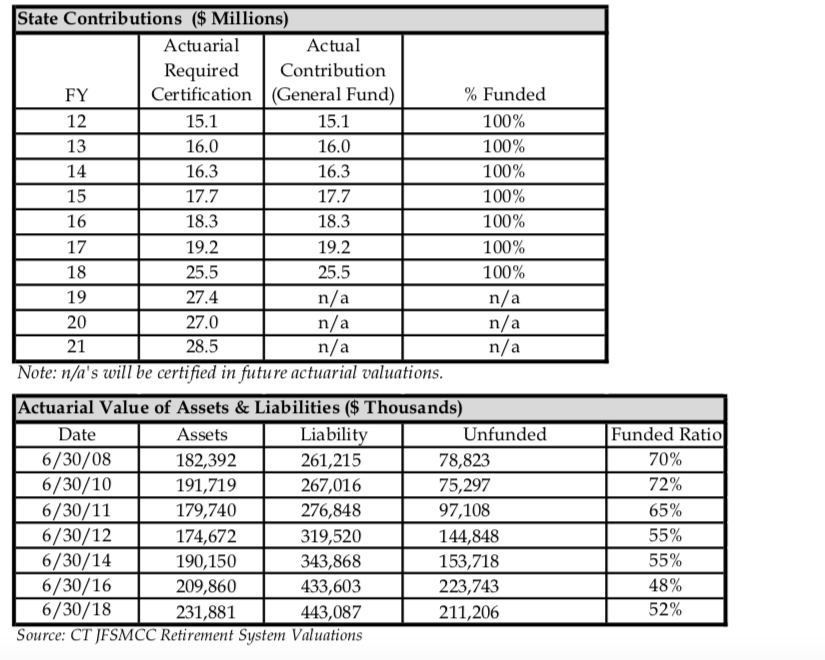Since 2012, Connecticut has paid the full annual cost of pensions for the state’s Judges, Family Magistrates and Compensation Commissioners Retirement System, nevertheless the pension debt for judges has increased during that time.
Although much smaller than Connecticut’s other retirement systems for teachers and state employees, the JFMCC Retirement System offers a glimpse into how the state’s long-term debt problem is not easily solved.
According to a fact sheet released by the Office of Fiscal Analysis, between 2012 and 2018 unfunded liabilities for the JFMCC Retirement System increased by $66.3 million to $211.2 million even as Connecticut paid the full annually required contribution toward the pensions.
This left the JFMCC system only 52 percent funded, down from 55 percent in 2012 and 70 percent in 2008.

Part of the problem is that Connecticut did not make any contributions to the JFMCC Retirement System in 2010 or 2011, leaving a $31.6 million gap, according to the state’s actuarial valuations.
The other part of the problem is that until 2017, the JFMCC Retirement System assumed an 8 percent return on the funds’ investments, but did not reach that goal on a year-over-year basis.
According to the State Treasurer’s Office, the State Judges Fund — which is responsible for the JFMCC Retirement System’s investments — returned 7.31 percent over the past five years.
The unfunded pension liabilities have driven the cost of employing state judges higher. According to a release by the State Comptroller’s Office, fringe benefits for judges, family magistrates and compensation commissioners now total 97.97 percent of payroll, essentially doubling the price tag for each employee.
Gov. Dannel Malloy’s administration began making the full annual required contribution in 2012 and continued to pay the full ARC through 2018.
The cost of the JFMCC system rose from $15.1 million in 2012 to $25.5 million in 2018 to cover pensions for 493 active and retired judges — an increase of 68 percent in six years.
The yearly cost of the JFMCC system to taxpayers is a drop in the bucket compared to state payments toward its major pension funds like the State Employee Retirement System and the Teachers Retirement System.
During his administration, Malloy made a point to fully fund the state’s pension systems, even noting that all of the increased revenue from the 2011 and 2015 tax increases went toward Connecticut’s pension debt.
Despite full funding, the unfunded liabilities for SERS has continued to grow, while TRS has shown slight improvement, but the costs continue to escalate and contribute toward Connecticut’s ongoing budget deficits.
Between 2012 and 2018, the funded ratio for SERS declined from 42.3 percent to 38 percent and Connecticut’s payments toward the plan increased from $1.2 billion to $1.7 billion, according to the state’s actuarial reports.
For the same time period TRS went from 55.2 percent funded to 57.7 percent. Payments to TRS, however, grew from $757 million in 2012 to $1.2 billion in 2018 and are projected to grow to $1.4 billion by 2021, according to the state reports.
Malloy lowered the assumed rate of return for SERS and the JFMCC Retirement System in 2017 to 6.9 percent to be more in line with actual market returns. Malloy also stretched out SERS payments until 2044 to prevent the costs from spiking.
Nevertheless, SERS payments are projected to grow to $2.2 billion by 2023, while TRS payments could spike much higher by 2032 — an estimated $3.5 billion per year or higher, depending on market returns.
Malloy proposed stretching out payments to the teachers’ pension system, but State Treasurer Denise Nappier warned it would violate the terms of a $2 billion pension obligation bond the state used to bolster the fund in 2008.
According to OFA’s fact sheet, the average pension for retired judges, family magistrates and compensation commissioners is $97,293. There are currently 209 active members and 284 retirees, 89 percent of whom are former judges.

